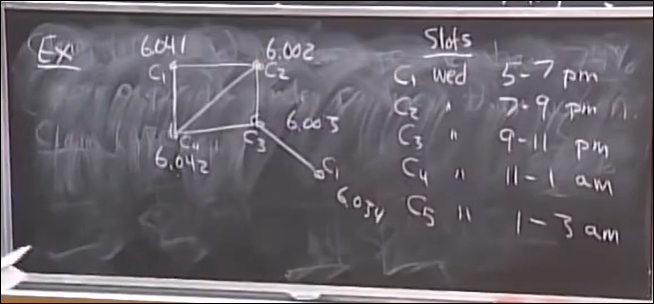离散数学P6 Graph Theory and Coloring
【P6】 -Mathematics for Computer Science_哔哩哔哩_bilibili
Claim(University Chicago): on average, men have 74% more opposite gender partners than women.
Claim(ABC News):on average, men have 233% more opposite gender partners than women.
Def:A graph G is a pair of sets (V, E) where
V is a nonempty set of items called vertices or nodes.
and E is a set of 2-items subsets of V called edges.
🔍 区别和倾向用法
| 术语 | 领域倾向 | 含义与用法解释 |
|---|---|---|
| Vertex / Vertices | 更偏向数学图论术语(Graph Theory) | 强调的是图的结构和拓扑关系,源自几何 |
| Node / Nodes | 更偏向计算机科学或网络分析 | 强调点作为实体、单元,如数据结构、网络中的计算单元、树的节点 |
Sample:
V:{x1,x2,x3,x4,x5,x6,x7}
E:{{x1,x2}, {x1,x3}, ..., {x5,x7}} 边的表示也可以x1-x2,有向图的时候加个箭头x1->x2
V不可以为空,E可以为空∅
Def: Two nodes xi and xj are adjacent, if {xi,xj}∈E
Def: An edge e={xi,xj} is incident to xi and xj.
在图论中:
A vertex and an edge e are incident if v is one of the endpoints of 。
也就是说,如果一个点在某条边的两端之一,就说这条边“incident to”这个点。
Def: the number of edges incident to a node is the degree of the node.
Def: A graph is simple if it has no loops or multiple edges. loop是一个node自己连接自己, multiple edges是两条边连接的node是相同的。
Def:Am = average # of opposite gender partners for men.
Def:Aw = average # of opposite gender partners for women.
What is Am/Aw=? 1.74, 3.33
Am=Sumx属于Vm的deg(x)/Vm=|E|/|Vm|
Aw=Sumx属于Vw的deg(x)/Vw=|E|/|Vw|
Bipartite graph(二部图) 是图论中一种结构清晰、性质良好的图。以下是它的定义、关键特性、判定条件、应用与推论的系统整理。
一个无向图 G = (V, E) 是二部图(bipartite graph),当且仅当其顶点集 V 可以分成两个不相交的子集 V1 和 V2,满足:
每一条边都连接一个来自 V1 的点和一个来自 V2 的点,即不存在任何一条边连接同一子集内的两个顶点。
Am/Aw=(E/Vm)/(E/Vw)=(E/Vm)*(Vw/E)=Vw/Vm=1.0325
给不同的课程排期末考试的时间,引入graph coloring问题
Graph coloring problem:Given a graph G and K colors, assign a color to each node, so that adjacent nodes get different colors.
Def: The minimum value of K for which such a coloring exists is the Chromatic Number of G. 着色数χ(G)

Bacic Coloring Algorithm: for G(V,E)
1.Order the nodes V1,V2,...,Vn
2.Order the colors C1,C2,...
3.For i=1,2,...,n
Assign the lowest legal color Vi
Theorem: If every node in n-node G has degree<=d, the Basic Algorithm uses at most d+1 colors for G.
Proof by induction:
Suppose a graph with n nodes
Base Case: n=1, 0 edges, and degree is 0, and 1 color works, so d+1 is true
Inductive Step:Assume P(n) is true for induction
Let G=(V,E) be any (n+1)-node graph. Let d=max degree in G
Order the nodes V1,V2,...,Vn.Vn+1
Remove Vn+1 from G to create G'=(V', E') 移除一个node,不会让degree变大
G' has max degree<=d and n nodes, so P(n) says Basic Algorithm uses d+1 corlors for V1,V2,...,Vn
Vn+1 has <=d neighbors 因为P(n+1)的degree1,假设就是Vn+1这个node
there exist color in {C1,C2,...,Cd+1} not used by any neighbors
Give Vn+a that color.
=>Basic Algorithm uses <=d+1 colors for G=>P(n+1)
Def: A graph G(V,E) is bipartite if V can be split into VL and VR, so that all eges connect a node in VL to a node in VR.



 浙公网安备 33010602011771号
浙公网安备 33010602011771号